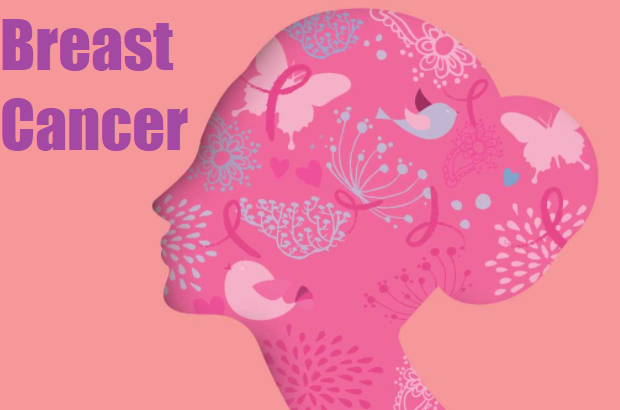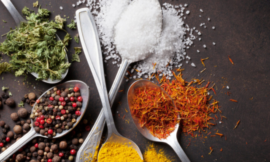Breast cancer is the cancer which form in cells of breasts. Cancer occurs when changes called mutations take place in genes that regulate cell growth. The mutations let the cells divide and multiply in an uncontrolled way. Breast cancer is also common in women like skin cancer. Typically, the cancer forms in either the lobules or the ducts of the breast. Lobules are the glands that produce milk, and ducts are the pathways that bring the milk from the glands to the nipple. Cancer can also occur in the fatty tissue or the fibrous connective tissue within your breast.
Breast cancer can occur in both men and women, but it’s far more common in women. In its early stages, breast cancer may not cause any symptoms. In many cases, a tumor may be too small to be felt, but an abnormality can still be seen on a mammogram. So knowing the symptoms of breast cancer is important.
Symptoms
The first symptoms of breast cancer usually appear as an area of thickened tissue in the breast or a lump in the breast or an armpit.
Other symptoms include:
- pain in the armpits or breast that does not change with the monthly cycle
- pitting or redness of the skin of the breast, similar to the surface of an orange
- a rash around or on one of the nipples
- discharge from a nipple, possibly containing blood
- a sunken or inverted nipple
- a change in the size or shape of the breast
- peeling, flaking, or scaling of the skin on the breast or nipple
These are the symptoms of breast cancer, if you can the symptoms you need to consult your doctor because every breast lumps are not cancerous.
Causes
Breast cancer occurs when some breast cells begin to grow abnormally. These cells divide more rapidly than healthy cells do and continue to accumulate, forming a lump or mass. Cells may spread (metastasize) through your breast to your lymph nodes or to other parts of your body.
Breast cancer most often begins with cells in the milk-producing ducts (invasive ductal carcinoma). Breast cancer may also begin in the glandular tissue called lobules (invasive lobular carcinoma) or in other cells or tissue within the breast.
Researchers have identified hormonal, lifestyle and environmental factors that may increase your risk of breast cancer. But it’s not clear why some people who have no risk factors develop cancer, yet other people with risk factors never do. It’s likely that breast cancer is caused by a complex interaction of your genetic makeup and your environment.
Doctors estimate that about 5 to 10 percent of breast cancers are linked to gene mutations passed through generations of a family.
A number of inherited mutated genes that can increase the likelihood of breast cancer have been identified. The most well-known are breast cancer gene 1 (BRCA1) and breast cancer gene 2 (BRCA2), both of which significantly increase the risk of both breast and ovarian cancer.
Risk factors
The exact cause of breast cancer remains unclear, but some risk factors make it more likely. It is possible to prevent some of these risk factors.
Being female : Women are much more likely than men are to develop breast cancer.
Increasing age : The risk of breast cancer increases with age. At 20 years, the chance of developing breast cancer in the next decade is 0.06%. By the age of 70 years, this figure goes up to 3.84%.
Inherited genes that increase cancer risk : Certain gene mutations that increase the risk of breast cancer can be passed from parents to children. The most well-known gene mutations are referred to as BRCA1 and BRCA2. These genes can greatly increase your risk of breast cancer and other cancers, but they don’t make cancer inevitable.
Radiation exposure : If you received radiation treatments to your chest as a child or young adult, your risk of breast cancer is increased.
Beginning your period at a younger age. Beginning your period before age 12 increases your risk of breast cancer.
Having never been pregnant. Women who have never been pregnant have a greater risk of breast cancer than do women who have had one or more pregnancies.
Postmenopausal hormone therapy. Women who take hormone therapy medications that combine estrogen and progesterone to treat the signs and symptoms of menopause have an increased risk of breast cancer. The risk of breast cancer decreases when women stop taking these medications.
Body weight : Women who become overweight or develop obesity after menopause may also have a higher chance of developing breast cancer, possibly due to increased estrogen levels. High sugar intake may also be a factor.
Drinking alcohol : A higher rate of regular alcohol consumption appears to play a role in breast cancer development. Women who consume alcohol have a higher risk of breast cancer than those who do not. Those who drink moderate to heavy levels of alcohol have a higher risk than light drinkers.
Types
There are several different types of breast cancer, including:
- Ductal carcinoma: This begins in the milk duct and is the most common type.
- Lobular carcinoma: This starts in the lobules.
Invasive breast cancer occurs when the cancer cells break out from inside the lobules or ducts and invade nearby tissue. This increases the chance of cancer spreading to other parts of the body.
Noninvasive breast cancer develops when the cancer remains inside its place of origin and has not yet spread. However, these cells can sometimes progress to invasive breast cancer.
Treatment
Treatment will depend on several factors, including:
- the type and stage of the cancer
- the person’s sensitivity to hormones
- the age, overall health, and preferences of the individual
The main treatment options include:
- surgery
- Radiation therapy
- Biological therapy, or targeted drug therapy
- hormone therapy
- Chemotherapy
Factors affecting the type of treatment a person has will include the stage of the cancer, other medical conditions, and their individual preference.
Surgery
If surgery is necessary, the type will depend on both the diagnosis and individual preference. Types of surgery include:
Lumpectomy: This involves removing the tumor and a small amount of healthy tissue around it.
A lumpectomy can help prevent the spread of the cancer. This may be an option if the tumor is small and easy to separate from its surrounding tissue.
Mastectomy: A simple mastectomy involves removing the lobules, ducts, fatty tissue, nipple, areola, and some skin. In some types, a surgeon will also remove the lymph nodes and muscle in the chest wall.
Sentinel node biopsy: If breast cancer reaches the sentinel lymph nodes, which are the first nodes to which a cancer can spread, it can spread into other parts of the body through the lymphatic system. If the doctor does not find cancer in the sentinel nodes, then it is usually not necessary to remove the remaining nodes.
Axillary lymph node dissection: If a doctor finds cancer cells in the sentinel nodes, they may recommend removing several lymph nodes in the armpit. This can prevent the cancer from spreading.
Reconstruction: Following mastectomy, a surgeon can reconstruct the breast to look more natural. This can help a person cope with the psychological effects of breast removal.
The surgeon can reconstruct the breast at the same time as performing a mastectomy or at a later date. They may use a breast implant or tissue from another part of the body.
Radiation therapy
A person may undergo radiation therapy around a month after surgery. Radiation involves targeting the tumor with controlled doses of radiation that kill any remaining cancer cells.
Biological treatment
Targeted drugs can destroy specific types of breast cancer. Examples include:
- trastuzumab (Herceptin)
- lapatinib (Tykerb)
- bevacizumab (Avastin)
These drugs now easily available in most of the online pharmacies, some medicines are not available in local pharmacies, especially top manufactures drugs .On these situation online pharmacies really beneficial, they provide prescription and unprescription medicines. Some pharmacies provide discounts on cancer medicines also, like GDMeds, Apollo, 984degree pharmacies are provide discounts on cancer medicines. GDMeds provide special coupon code for all type of cancer medicines.
Treatments for breast and other cancers can have severe adverse effects. When deciding on a treatment, people should discuss the potential risks with a doctor and look at ways to minimize the side effects.
Hormone therapy
Doctors use hormone blocking therapy to prevent hormone sensitive breast cancers from returning after treatment. Hormone therapy may be used to treat estrogen receptor (ER)-positive and progesterone receptor (PR)-positive cancers.
They usually administer hormone blocking therapy after surgery but might sometimes use it beforehand to shrink the tumor.
Hormone blocking therapy may be the only option for people who are not suitable candidates for surgery, chemotherapy, or radiotherapy.
Doctors may recommend a person has hormone therapy for 5–10 years after surgery. However, the treatment will not affect cancers that are not sensitive to hormones.
Examples of hormone blocking therapy medications may include:
- tamoxifen
- aromatase inhibitors
- ovarian ablation or suppression
- Goserelin, which is a luteinizing hormone-releasing agonist drug that suppresses the ovaries
Chemotherapy
A doctor may prescribe cytotoxic chemotherapy drugs to kill cancer cells if there is a high risk of recurrence or spread. When a person has chemotherapy after surgery, doctors call it adjuvant chemotherapy.
Sometimes, a doctor may choose to administer chemotherapy before surgery to shrink the tumor and make its removal easier. Doctors call this neoadjuvant chemotherapy.
These the treatment for breast cancer, identifying the symptoms and diagnosis is very important in the case of cancer.





